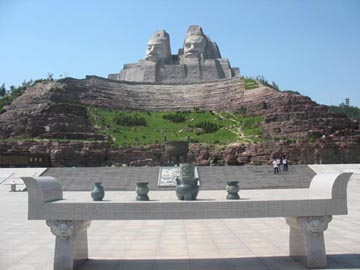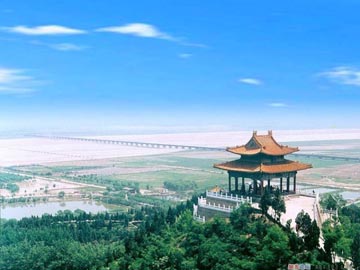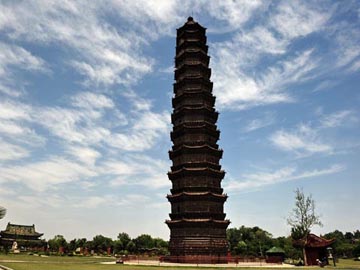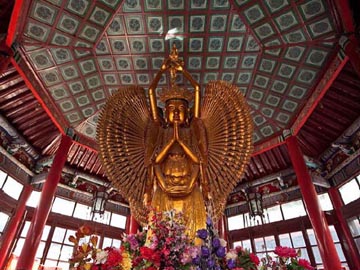|
In Henan it is very necessary to visit three cities namely Zhengzhou, Luoyang and Kaifeng.
Zhengzhou also enjoys a long history. It is the capital city of Henan Provinve. It covers an area of 7,500 square kilometers with the population of 6.6 million.
Shaolin Temple, at the foot of Song Mountain in Dengfeng City, was first built in 495AD. In 527AD, the eminent monk Dharma arrived at this temple and had nine years of meditation in a cave. He initiated the Zen Buddhism in China. He also taught them monks basic martial arts to improve their health and defend themselves. So the Shaolin Temple is the cradle of the Chinese Zen Buddhism and the Shaolin Martial Arts. Shaolin Temple has many exciting attractions, such as the Hall of Heavenly Kings, the Mahavira Hall, the Pagoda Forest, the Dharma Cave and the Shaolin Temple Martial Art Training Center.
 |
 |
Shaolin
Temple Scecnic Zone |
The
Pagoda Forrest |
The Pagoda Forest is most important scenic spot in the temple. It is the largest of China's pagoda complexes where buried the eminent monks’ remains in different dynasties.
The Shaolin Temple Kungfu (Martial Arts) Training Center is very popular for martial arts lovers. Shaolin monks have been practicing Kung Fu for over 1,500 years. Now quite a lot of people from all over the world come here to learn and practice Chinese martial arts. The Martial art performance here shows the authentic Chinese Shaolin Kung Fu. For example, Tong Zi Gong, performed by teenagers, is a kind of martial art to train one's flexibility and strength.
Song Mountain has fine
natural scenery. It has 72 mountains, extends for about 70 kilometers
from east to west. There are many valleys, caves, pools and waterfalls.
The landscape is so unique that it has been given the title of 'International
Geological Park' by the UNESCO.
Song Mountain is close to the ancient capital city of Luoyang. The Emperors
in ancient always mounted Song Mountain to offer sacrifices. Many scholars,
eminent monks and famous Taoists chose this area as an important place
to give lectures, explain Buddhist sutras and develop the teachings of
different religions. Song Mountain is the birthplace of China Zen Buddhism.
It has many temples, such as Shaolin Temple and Songyue Temple.
 |
 |
Yan
Di and Huang Di, Chinese Ancestor |
Overview
Yellow River |
The Yellow River Scenic Area lies in the northwest of
Zhengzhou. It is around 30km from the city.
A number of cultural points are in the park. The western end of the park
contains the historic battle site where Liu Bang (who later became Emperor
Gauzu) defeated Xiang Yu to cement his rule in 202 B.C. as the first emperor
of the Han Dynasty. Yueshan Temple in the park is interesting. It has
a large number of pagodas containing the remains past monks at the temple.
The park also contains its own Stele Forest where 570 steles inscribed
by well known (to the Chinese at least) calligraphers. Five Dragon Peak
is an excellent place to view the Yellow River. The huge stone figure
of Huangdi with 100meters high is also worth seeing.
The city of Luoyang
is one very important city in ancient China. It served as the capital
city of thirteen different Chinese kingdoms. Luoyang is endowed with countless
historical and cultural relics. The famous Tang Triple Colors Potteries
produced in Luoyang are world famous.
The White Horse Temple, in the suburb of Luoyang City,
is the first Buddhist Temple built in China. It was built in 68AD in the
Eastern Han Dynasty. According legends, in the year of 64AD of the Eastern
Han Dynasty (25-220AD), Emperor Ming sent a delegation to Western Regions
to learn Buddhism. After three years, two eminent Indian monks, She Moteng
and Zhu Falan, came back with the delegation. They brought a white horse
to carry Buddhist sutras and Buddhist figures. This was the first time
that Buddhism appeared in China. To express his thanks to the two monks
and their white horse, the emperor ordered to build a monastery which
he named the White Horse Temple during the following year. The two monks
translated “Forty-two Chapter sutras” in the temple. Thus the temple became
a centre for Buddhist activity in China. It is for this reason that the
temple is honored as the “Cradle of Buddhism in China”. The temple boasts
great antique architecture which has remained intact for several hundred
years. The Hall of Heavenly Kings, Hall of the Great Buddha, Hall of Mahavira,
Hall of Guidance and the Cool and Clear Terrace appear are the main spots
in the temple.
 |
 |
White
Horse Temple |
Longmen
Grottoes |
The longmen Grottoes
are located 12km south of Luoyang City. They are a treasure house of ancient
Buddhist cave art. The grottos were hewed and carved during the Northern
Wei Dynasty (386-534), when the rulers relocated their capital at Luoyang
near the end of the 5th century. At that time Buddhism was wide spreading
in China and was venerated by the imperial court. The Buddhists adopted
the practice of carving rock temples, dedicated to the Buddha.
The construction of the Longmen Grottoes began in 493 during the reign
of Emperor Xiaowen and continued through the successive six dynasties,
including Tang and Song, for a span of over 400 years. Altogether there
are around 2300 niches and caves. 100,000 statues of the Buddha, Bodhisativa,
and Arhat, and 2,800 inscribed stone tablets along the 1-km-long cliff
of Mt. Longmen on the west and Mt. Xiangshan on the east of the Yihe River.
30% of these cave sculptures belong to the Northern Wei Dynasty, 60% belong
to the Tang Dynasty, and 10% belong to other periods. The style of sculpture,
the design of clothing and the facial expression on statues, as well as
carving methods of the statues carved in the Northern Wei Dynasty show
little foreign influence, rather they exhibit the pinnacle of development
of Chinese grotto art. The 11 Buddha statues in the Binyang Cave, typical
Northern Wei carvings, represent a style in transition from the simple
and compact depictions in the Yungang Grottoes of Datong, Shanxi Province,
to the vigorous and realistic Tang Dynasty sculptures.
While the cave sculptures of the Tang Dynasty are of a vigorous, elegant
and realistic style, the stone statues in Fengxian Cave, carved under
the edict of Empress Wuzetian (reigned 690-705), can be considered as
the most typical of the period. These consist of a 17.14-meter-high statue
of Vairocana Buddha, and a series of pairs of Bodhisattvas, heavenly kings,
protectors and worshippers. The Buddha has a well-filled figure, a sacred
and kindly expression and an elegant smile. The huge statue of Vairocana
Buddha is today praised as being the quintessence of Buddhist sculpture
in China. At the sides of Vairocana there are two statues of Vairocana
Buddha's disciples, Kasyapa and Ananda, wearing prudent and devout expressions.
The figures of Bodhisattvas and devas can also be found in the temple.
Some have dignified and genial expressions, while others are majestic
and fiery. The various appearances and delicate designs are the representations
of Empire Tang's powerful material and spiritual strength as well as the
high crystallization of people's wisdoms.
Wanfo Cave, completed in 680, is a typical cave of the Tang Dynasty with
two rooms and square flat roofs. Its name is due to the 15,000 small statues
of Buddha carved in the southern and northern walls of the cave. The main
Buddha Amida sits on the lotus Sumeru throne, having a composed and solemn
face. The wall behind Amida is carved with 54 lotuses upon which there
are 54 Bodhisattvas in different shapes and with various expressions.
In addition, there are lifelike reliefs of pretty and charming singers
and dancers on the wall. The singers are accompanied by various kinds
of instruments and the dancers dance lightly and gracefully to the music.
The whole model in the cave has created a lively and cheerful atmosphere.
On the southern wall outside the cave is carved a statue of Kwan-yin of
85 centimeters in height, holding a pure bottle in the left hand and deer's
tails in the right hand. This figure is well designed and is regarded
as an example of Bodhisattva statues of Tang Dynasty in Longmen.
Luoyang is also reputed for its numerous types of peony.
In Chinese culture peony symbolizes magnificence, abundance and thriving.
Luoyang's peonies rank as the best in the country due to their long growing
period and wide varieties. Every April, the famous Peony Exhibition attracts
many people from all over the world. During that period of time the whole
city permeates the fragrance of peony. Peony is also the national follower
in China.
Kaifeng is also one of the
ancient capital cities in China. It served as the capital for seven dynasties.
Especiall in the Northern Song Dynasty (960-1127AD), it was the cultural
and economic center of China. From the famous picture “Qingmingshanghetu”
(This picture, painted by Zhang Zeduan, is a painted scroll which is 525
cm in length and 25.5 cm in width depicting life along Bian River during
the Qingming Festival. The scenes in this painting are highly detailed
and the spectacle is magnificent. There are large numbers of people and
buildings. The people are shown in a variety of contemporary clothes that
indicate their social standing and occupations. There are many shops along
the street corded with all kinds of people. The picture indicated the
prosperous scenes of the ancient Kaifeng City.), people can feel the prosperity
of ancient Kaifeng.
The Iron Pagoda is erected strikingly in the northeast
of Kaifeng City. It is renowned as the best pagoda in China for its superb
construction and elegance. Built in 1094 in the Song Dynasty (960-1279),
the pagoda is the most eye-catching element of Kaifeng.
The pagoda is not made of iron but glazed bricks. Seen from a distance
the pagoda appears to be made of iron due to the color of the bricks.
The thirteen-layered, octagonal pagoda is over 55 meters high. The unique
construction used bricks but followed a design of wooden pagodas. Tenons,
mortises and slots were all made of bricks and they were well connected
into a complete unity. The Irion Pagoda has experienced the baptizing
of nature, earthquakes, flood and destructions of human being for over
900 years but it still towers there. That is really a architectural wonder.
The glazed-bricks on the surface layer are exquisitely engraved. More
than 50 distinct patterns are used, such as figures of Buddha and Bodhisattva,
different flowers, and lions and kylins. Each pattern is of a high artistic
standard show the excellent craftsmanship. The steps of the brick stair
spiral to the top from where you can enjoy a view of the whole city.
The Iron Pagoda was placed on the list of major historic and cultural
sites under state protection in 1961.
 |
 |
Iron
Tower |
Bodhisattva
Statuein Xiangguo Temple |
Xiangguo Temple was first
constructed in 555 in the Northern and Southern Dynasties (420-589). It
is one of the ten famous temples in Chinese history and plays an important
role in the development of Buddhism in China.
The temple was rebuilt in the Tang Dynasty (618-907), and was bestowed
the name Xiangguo Temple by Emperor Ruizong. The temple reached its heyday
in the Song Dynasty (960-1279). It became an international Buddhism center,
attracting many foreign envoys and great monks. That is because Kaifeng
was the capital city of the Northern Song Dynasty. It contributed a lot
to the cultural exchanges between China and other countries. Most buildings
existing today were built in the Qing Dynasty.
The most remarkable building in the temple is the Arhat Hall, which is
also called Octagonal Glazed Hall. Inside, placed a wooden statue of Avalokitesvara
Bodhisattva, which was carved from the trunk of a huge gingko tree during
the reign of Emperor Qianlong in the Qing Dynasty. The four sides of the
statue are of the same sculpt. On each side, there are six big hands and
three to four layers of small fanlike hands, with an eye on each palm.
The number of the hands totals 1,048, and likewise the number of the eyes.
The statue highly embodies the fine workmanship of the Qing Dynasty.
Kaifeng is famous for its chrysanthemum floriculture.
Every autumn many kinds of chrysanthemum in different colors and different
forms are in blossom. That is really amazing. Chrysanthemum represents
purified characters of people. It was specially favored by scholars in
China.
Mobile:(+86-1350 110 3837) Wechat:(13501103837) E-mail: chinasilkrug@msn.com